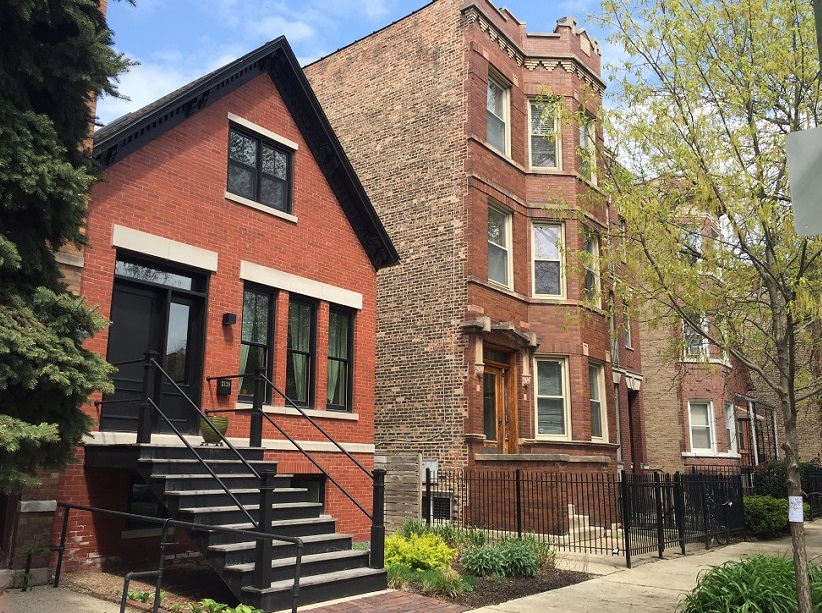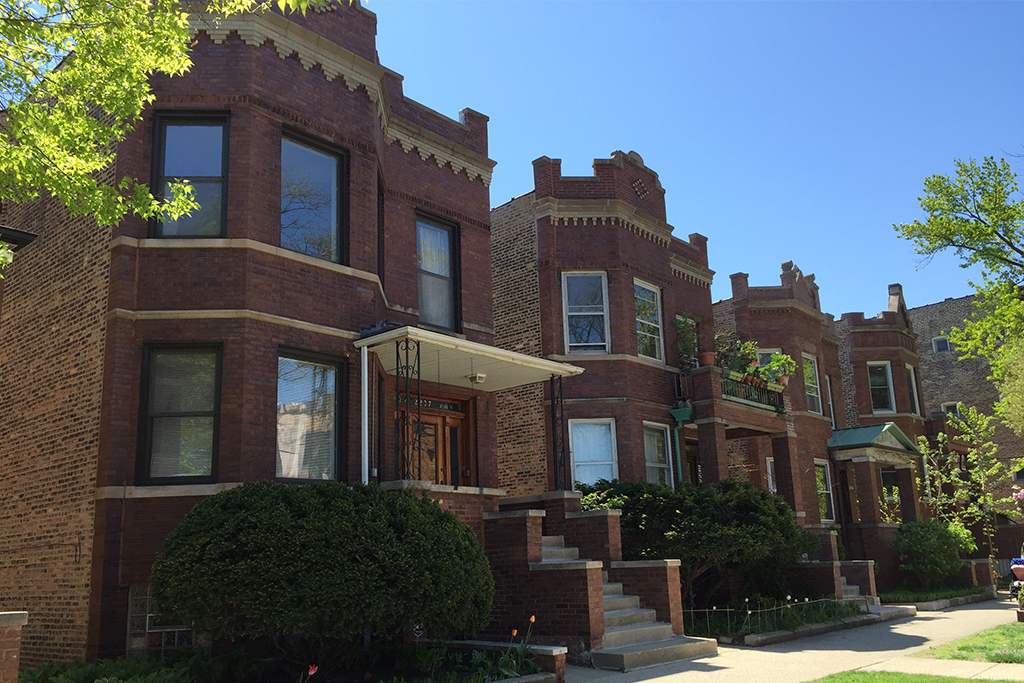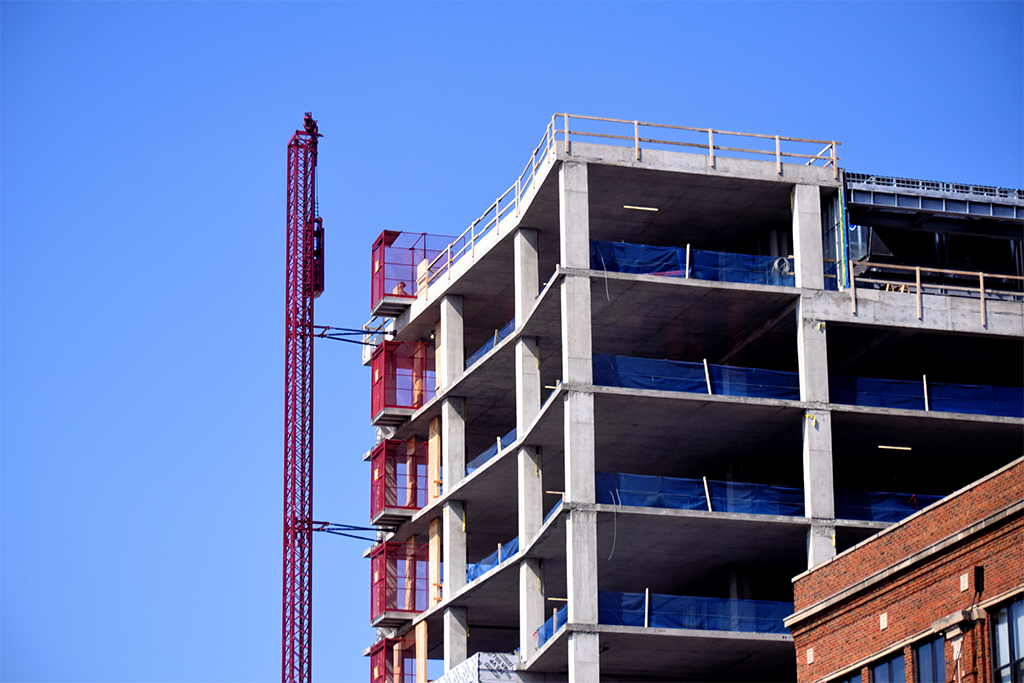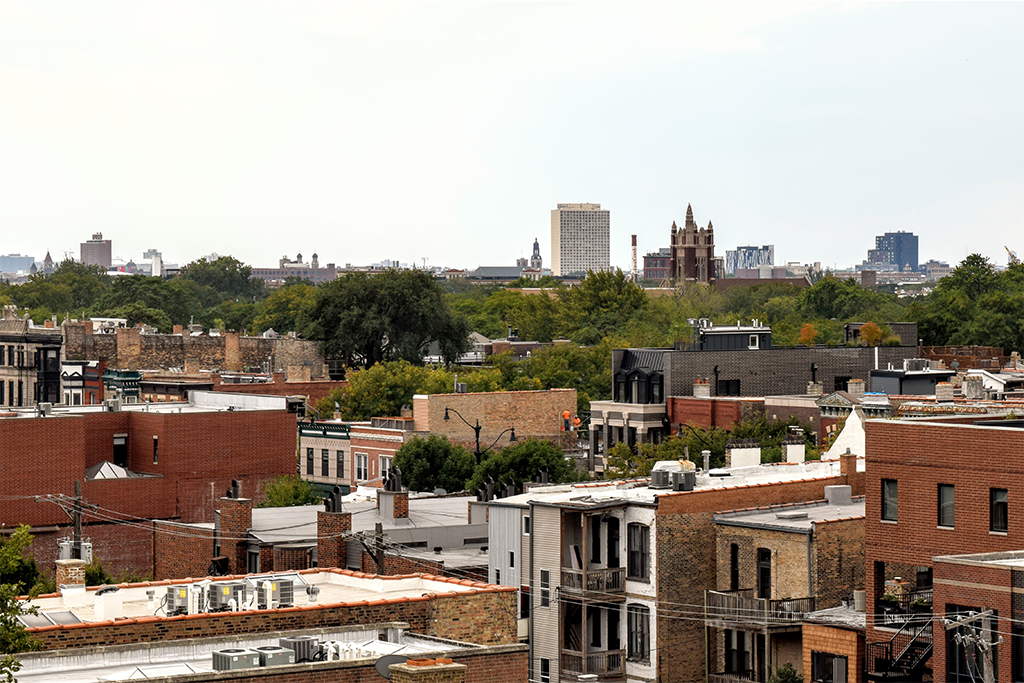Chicago’s 2 to 4 unit housing stock plays a unique and critical role in the city’s housing landscape, providing opportunities for affordable housing, homeownership, and wealth-building in many of the city’s communities. This type of housing is also undergoing tremendous change. Recent IHS analysis has found that Chicago is losing 2 to 4s throughout the city, especially in higher-cost communities and neighborhoods seeing rising home values. These losses put increasing pressure on the city’s available affordable housing stock.
This IHS analysis did not occur in a vacuum. The Institute has spent years researching the city’s 2 to 4 unit housing market, often beginning with technical assistance engagements with community stakeholders and policymakers looking to better understand and protect this housing stock. As these organizations and IHS reports have highlighted the importance of preserving affordable housing, the city has implemented new policies that attempt to directly address the loss of 2 to 4 unit buildings in Chicago’s most rapidly changing communities.
This blog will provide an overview of the current state of 2 to 4 unit housing in Chicago, new pilot programs directed at preserving multi-unit housing in Chicago, and IHS’s work with community partnerships over the years that have provided insight on the 2 to 4 unit housing market.
The Current State of 2 to 4s
As one of the most recognizable fixtures of Chicago’s housing stock, two-. three-, and four-flat buildings have long been a staple of the city's unsubsidized, naturally-occurring affordable housing stock. These buildings, found across all areas of the city, provide for just over 25 percent of all residential units in Chicago; they stand as a dependable form of housing for low- and moderate-income households and are among the city’s most affordable unit type.
With that in mind, these properties are disappearing. Since 2013, Chicago has lost more than 4,800 2 to 4 unit buildings representing 11,775 rental and owner-occupied housing units, according to IHS’s most recent report. The highest concentrations of lost 2 to 4s occurred in high-cost communities, where most of the lost parcels were converted to single-family homes. Two to 4s are also being lost in lower-income communities, with a majority of lost housing turning into non-residential uses, typically vacant land. Overall, 47.5 percent of lost 2 to 4 unit buildings were replaced by single-family homes, and 29.6 percent were replaced with non-residential land uses.
For communities surrounding The 606 linear park, the loss of naturally occurring affordable housing and rising house prices exacerbates displacement pressures for lower-income renters and vulnerable residents. Building upon a previous analysis, IHS's case study found that 2 to 4 sales prices around the more affordable western section of the trail were rapidly increasing. While there are opportunities to preserve existing affordable housing around The 606, the window of opportunity may be closing as legacy 2 to 4s dwindle and house prices climb.
New Interventions in Pilsen and the 606
In January 2020, Chicago City Council passed a temporary six-month moratorium on demolitions in residential areas surrounding The 606, citing IHS’s research on rising house prices surrounding the trail. The moratorium stopped the issuance of any residential demolition permit or rezoning along the western half of The 606 except for the construction of affordable housing or demolitions due to safety concerns (Figure 1). The moratorium was extended to April 1, 2021 in order to slow market pressures as City Council deliberated and developed a longer-term legislative solution to address the ongoing loss and demolition of affordable housing along the trail.
Figure 1. Residential areas along the western half of The 606 trail covered under the City of Chicago's temporary demolition moratorium, anti-deconversion ordinance, and demolition surcharge pilot.
During the temporary demolition moratorium, IHS conducted technical assistance for the Department of Housing to inform potential policy interventions to alleviate displacement pressures in communities surrounding The 606 and in parts of Pilsen, a community also experiencing affordable housing challenges. In January 2021, City Council passed two new policies for these areas to preserve the existing affordable housing stock and encourage development that better conforms to existing neighborhood densities. Similar to zoning ceilings that limit residential density, the new anti-deconversion ordinance establishes a minimum residential density by prohibiting the construction of single-family homes and conversion of multifamily-unit buildings to single-family residences in areas shown in Figure 1 and 2. However, single-family homes are allowed by-right on streets where they are the predominant housing type in RS3 and RS3.5 zones surrounding The 606 and in certain RT and RM zones in Pilsen.
Figure 2. Residential areas in Pilsen covered under the City of Chicago's anti-deconversion ordinance and demolition surcharge pilot.
As a complement to the anti-deconversion policy, City Council passed a year-long pilot program in April 2021 that covers the same districts to discourage property owners from demolishing the existing residential housing stock. Citing data from IHS's analyses and technical assistance on rising house prices and losses of the 2 to 6 unit stock, the new legislation imposes a $15,000 surcharge to demolish a single-family, townhouse, or two-flat building and a $5,000 per unit surcharge for a multifamily building with three or more units. Revenue generated from the pilot program will support the Chicago Community Land Trust.
Our Work with Community Organizations
In addition to IHS’s work with city agencies, the Institute actively collaborates with various community organizations and practitioners working to preserve 2 to 4 unit buildings in a diverse set of Chicago communities. These collaborations have played a critical role in IHS's research, including two reports on the characteristics and patterns of lost 2 to 4 unit buildings throughout Chicago that build on years of data developed through technical assistance requests.
Building capacity to preserve foreclosed 2 to 4s and keep them affordable. Communities United’s ROOTS initiative has been working to preserve affordable housing with a focus on 2 to 4 unit buildings since 2014. Since its inception, IHS has provided data to help ROOTS understand pressures on the 2 to 4 housing stock in their community, which are at risk of being bought by cash investors and potentially being lost as sites of affordable housing. Working with the Chicago Metropolitan Housing Development Corporation and Enterprise Community Partners, ROOTS buys and rehabs these foreclosed properties to provide affordable housing in Albany Park, Austin, Belmont-Cragin, Roseland, and West Ridge. In IHS’s most recent report, the Institute found that 2 to 4 unit buildings with a foreclosure filing are far more likely to be lost than those without a foreclosure.
Assessing barriers and opportunities for accessory dwelling units. More recently, IHS has helped Communities United investigate the impact accessory dwelling units (ADUs) can have on owner-occupied 2 to 4 unit housing by providing data on owner occupancy and housing tenure in these buildings. Communities United was a stakeholder in the Urban Land Institute’s report on the ADU initiative, for which IHS provided analysis that combined data on parcel characteristics and zoning classification to highlight the opportunity for ADU development in different neighborhood market contexts. As Chicago has begun experimenting with allowing ADUs in designated pilot areas, it's increasingly important to identify how ADU development can impact 2 to 4 unit homes and the affordable housing market.
Stabilizing homeowners and communities through targeted outreach. On the Southwest Side, IHS has had a long relationship with the Southwest Organizing Project (SWOP), based in Chicago Lawn. IHS provides the organization with both housing and demographic data to aid in the organization’s Reclaiming Southwest Chicago campaign, a multifaceted effort to create affordable housing and decrease the number of vacant buildings in SWOP communities. IHS helps SWOP identify key lenders active in the southwest side, information the organization uses to aid families facing foreclosure. IHS data also helps SWOP staff identify properties where owners may not be taking advantage of homeowner and senior exemptions, which helps target outreach for programs that could provide financial relief to many residents.
Many demographic characteristics IHS provides SWOP are now available on IHS’s data portal, including population age, race and ethnic composition, distribution of household incomes, poverty status, and tenure and housing cost burden. In IHS’s 2 to 4 housing characteristics report, IHS highlights the importance of the housing stock particularly in communities of color, such as majority-Latinx Chicago Lawn.
Tracking housing market recovery after the Great Recession. Since 2016, IHS has provided data analysis on single-family, 2 to 4 unit, and multifamily housing for the Greater Chatham Initiative (GCI) in Chatham, Avalon Park, Auburn Gresham, and Greater Grand Crossing on the south side. IHS has provided ongoing technical assistance to GCI as they work to develop programs to support the stable recovery of the community’s housing market after the foreclosure crisis and now during the COVID-19 recovery period. Among these projects IHS has provided detailed sales data, including interactive maps and data on likely investor-purchased properties, to help GCI keep close tabs on the housing market and evaluate the success of their housing programs and strategies.
In a guest blog authored by several IHS community partners, GCI noted that many of the first-time homeowners of 2 to 4 flats the organization helped attract to the community rely on rents to pay for their mortgages and are vulnerable to foreclosure during the pandemic due to increased economic instability. In Greater Chatham’s communities, IHS analysis shows that limited numbers of 2 to 4 unit properties have been lost to either single-family homes or non-residential uses, but these properties need ongoing investment and support to be able to provide ownership and wealth-building opportunities for neighborhoods residents.
Preserving affordability in rising markets through community ownership models. Organizations like the Latin United Community Housing Association (LUCHA) and the Logan Square Neighborhood Association (LSNA) used IHS data to identify displacement hotspots within the two regions identified by the recently-passed ordinances. LUCHA, which focuses on preserving affordability, providing resources for renters and owners, and promoting financial education, continues to use our data, like our Mapping Displacement Pressure project.
LUCHA, LSNA, the Center for Changing Lives, and the Spanish Coalition for Housing launched the Here to Stay Community Land Trust in Hermosa and Logan Square. Community land trusts are a collective ownership model where a non-profit entity actively acquires real estate to take it out of the private market and create a stock of permanently affordable homes. The model is an emerging tool for combatting the loss of affordable housing in neighborhoods with high displacement pressure.
Convening stakeholders to advance equitable development. These organizations partner with Elevated Chicago in the Here to Stay initiative. Elevated is a collaborative that focuses on community improvement through equitable transit-oriented development (ETOD). IHS works with Elevated on several fronts, providing housing and demographic data for the transit communities where it works and collaborating in community engagement projects.
Applying research and data to policy and practice during the COVID-19 pandemic. IHS also collaborates with the Preservation Compact on the Preservation Lab, an initiative to discuss and develop innovative strategies focused on preserving the existing, affordable housing supply. The Lab’s first white paper analyzed the potential impacts of COVID-19 on Chicago renters and the housing market and identified how rental assistance programs can serve the needs of vulnerable tenants and property owners. The Lab’s ongoing initiative focuses on strategies to support the naturally occurring affordable housing supply, of which 2 to 4 unit properties are a critical component.
What’s Ahead?
In the guest blog on the need for a collective approach to preserving 2 to 4 unit housing, partner organizations laid out short and long-term strategies to prevent displacement and preserve affordable housing in Chicago. As part of the Chicago Flats Initiative, IHS is actively working with these organizations - which include Communities United, Elevate Energy, Enterprise Community Partners, Garfield Park Community Council, The Greater Chatham Initiative, Neighborhood Housing Services of Chicago, The Preservation Compact, and Resident Association of Greater Englewood (R.A.G.E.) - to provide data and insight on the 2 to 4 housing market to inform strategies to preserve this important component of the housing stock. IHS continues to learn from community partners and develop new tools for understanding housing market conditions in Chicago. You can read IHS’s most recent report on 2 to 4 unit housing characteristics here and IHS’s most recent report on lost 2 to 4 unit buildings here.






